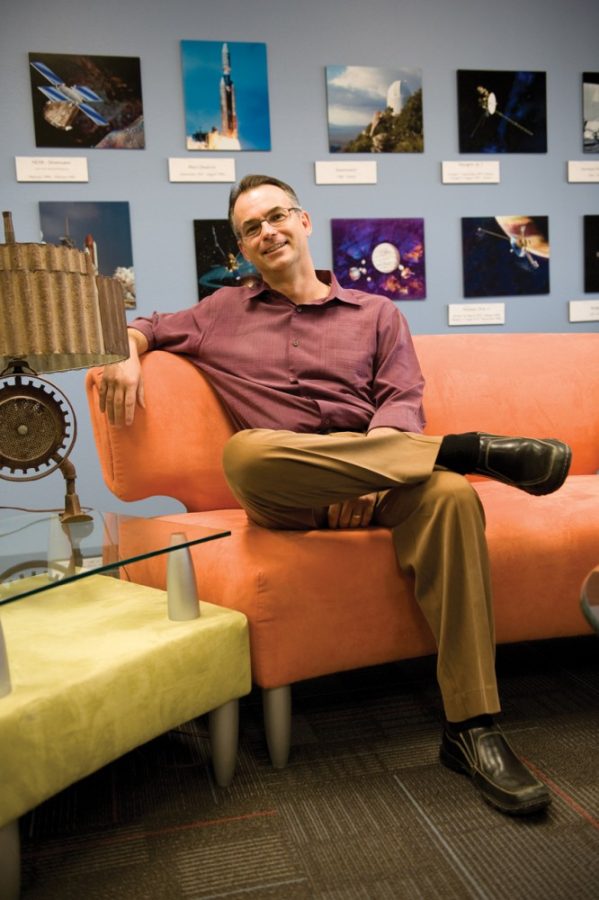A team of UA faculty and students is playing a central role in an asteroid mission set for 2016.
OSIRIS-REx is an asteroid sample return mission with the goal of analyzing, understanding and retrieving a sample from the “volatile and organic-rich remnant” of asteroid 1999 RQ36. The launch will take place in 2016.
OSIRIS-REx is an acronym describing aspects of the spacecraft and mission’s planned work; origins, special interpretation, resource identification, security and regolith explorer. Comprised of a partnership between the UA, NASA’s Goddard Space Flight Systems and Lockheed Martin, the mission is the third in NASA’s New Frontiers Program and the first U.S. asteroid sampling mission.
“For me, going to an asteroid is a different venue and has its own set of different challenges,” said Chris Shinohara, UA science operations center manager.
1999 RQ36 was chosen for the mission because it meets several criteria, including being a near-Earth asteroid, having an optimal orbit and a diameter of more than 200 meters and being a carbonaceous asteroid. In addition to being carbonaceous, which means it holds remnants from the original building blocks of terrestrial planets like Earth, the asteroid is potentially hazardous, with a 1 in 1800 chance of impacting the Earth in 2182, according to the mission’s website.
After its “planning and fabrication” phase and launch, the spacecraft will rendezvous with the asteroid from 2019 to 2021 to analyze it and retrieve at least a 60 gram sample for further inspection.
Dante Lauretta, the principal investigator and a lunar and planetary laboratory professor, said he forsees this being the most challenging part, because the spacecraft will have to “hover” and match the asteroid’s velocity and rotation. Compounding these difficulties, Lauretta and his team won’t be controlling the spacecraft in real time, so “after you hear it, everything will have already happened.”
In addition to the sample, the mission will study the Yarkovsky effect, a theory that states that the “daily heating of an object rotating could exert a small force on the object,” according to the mission’s website. If understood, this tiny daily push over time could help mitigate the risk of a 22nd century collision with Earth.
Lockheed Martin is currently constructing the OSIRIS-REx spacecraft, which is 6.6 feet on each side with two solar panels a combined 19.7 feet in length and a robot arm that will collect the surface material from the asteroid to return for sampling. After the gravel and debris are returned to Earth, they will be processed through a sample analysis for two years, until 2025, and then will be field checked to affirm or contradict past telescope observations and assumptions.
Lauretta recently met with John Holdren, the president’s senior adviser on science and technology issues, who he said was “very excited and very impressed” by the mission.
Beyond national higher-ups, the mission has UA students involved and excited as well.
Jon Cummings, a computer science junior and student software engineer for the OSIRIS-REx team, said the project not only sets the UA apart from other institutions, but also distinguishes the students working on the endeavor.
“It’s definitely cool,” Cummings said, “because employers look for more research focus and academic intrigue I guess, rather than people who just went to school to get their degree and raise their salary.”
Seeing this work put to use has also been a rewarding experience, he added.
“The coolest part is you’re actually involved in something that matters,” Cummings said. “A lot of the stuff I do in school is academic, like solely academic things that will never be used in the real world. Just things to help you learn basically, and the stuff I’m doing there [on OSIRIS-REx] is actually applicable and you learn a lot of good strategies of working with people in the field, seeing what it’s really like.”
Lauretta said that while the longevity of the project requires endurance, he’s learned to appreciate that aspect as well.
“I’m in a department, a planetary science lab where you plan missions to Saturn and Jupiter and outer solar systems and in Mars, and you’re used to a decade-long timeline for your operation space,” Lauretta said. “So it’s daunting, certainly, but it’s a great challenge and it’s a great career. I feel very honored to be working on a major NASA project like this.”









